The Economics and Statistics Division maintains archives of previous publications for accountability purposes, but makes no updates to keep these documents current with the latest data revisions from Statistics Canada. As a result, information in older documents may not be accurate. Please exercise caution when referring to older documents. For the latest information and historical data, please contact the individual listed to the right.
<--- Return to Archive
For additional information relating to this article, please contact:
September 08, 2017LABOUR MARKET TRENDS - AUGUST 2017 Nova Scotia's seasonally adjusted employment decreased by 5,600 to 444,600 in August 2017. Monthly employment changes have been in an up-and-down pattern throughout all months of 2017.
Compared to July, Nova Scotia’s labour force decreased by 900 to 487,800 in August. With labour demand falling at a faster pace than labour supply, the net result was a 1.0 percentage point increase in the seasonally adjusted unemployment rate to 8.9 per cent in August. Labour supply fell while there was a matching increase in the working age population (+900), resulting in a slight decline in the participation rate by 0.2 percentage points to 61.5 per cent in August. With a drop in the employment level (5,600), the employment rate decreased to 56.0 per cent.

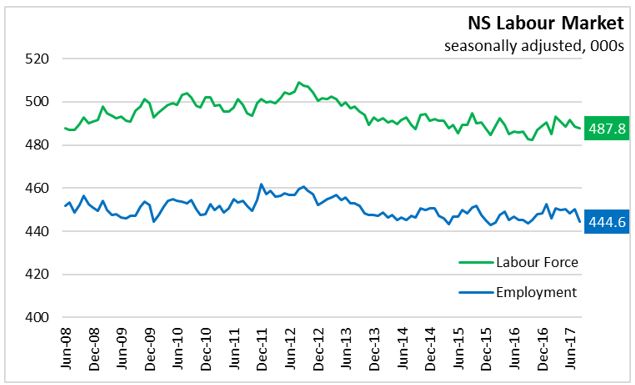
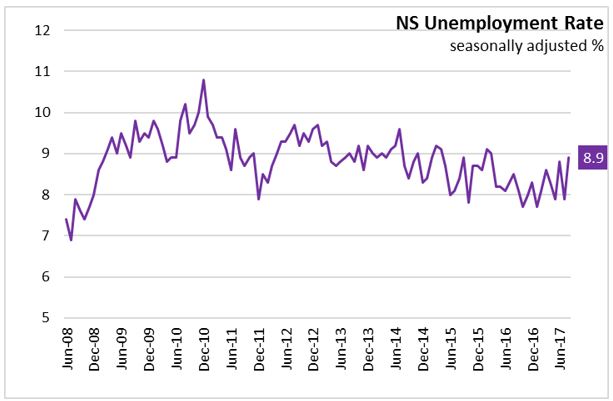
In August, the decrease in employment was in full-time jobs (-7,900) while part-time employment was up (+2,300).
During the first eight months of 2017 compared to the first eight months of 2016, there was an increase of 3,200 (0.7 per cent) in the average employment level. Average full time employment was down 1,700 while there were 5,000 more part-time jobs. The labour force was up 2,200 for the first eight months of 2017. With labour demand increasing at a faster pace than the labour supply, the net result was a decline in the average unemployment rate by 0.2 percentage points to 8.3 per cent. The labour force participation rate remained the same at 61.9 per cent. The employment rate increased slightly to 56.7 per cent.
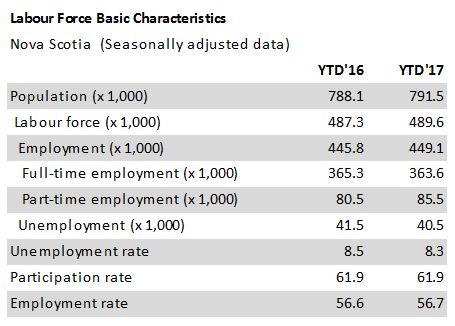
AGE COHORTS (January-August 2017 vs. January-August 2016)
The labour force survey population estimate of the 15-24-year age group declined by 1,400 comparing the first eight months of 2017 to the first eight months of 2016. This age group saw a decline of 1,700 in the labour force and 2,300 in employment during this period as the number of unemployed increased by 600. The unemployment rate increased to 16.3 per cent on average over the first eight months of 2017, compared with 15.0 per cent during the same period in 2016. The larger decline in employment compared to the decline in population led to a 1.4 percentage point decline in the youth employment rate to 53.4 per cent.
For Nova Scotians aged 25 to 54, the labour force increased by 600 and employment increased 1,900 (comparing the first eight months of 2017 with the same period in 2016). With growth in labour demand outpacing the growth in labour supply, the net result was a 0.4 percentage points decline in the unemployment rate for core aged workers to 7.0 per cent. With a rising labour force and a falling population (-3,400), the labour force participation rate for Nova Scotians aged 25 to 54 increased 1.0 percentage points to 86.1 per cent. The employment rate rose 1.3 percentage points to 80.2 per cent.
For those Nova Scotians aged 55 and over, the population, labour force and employment have all increased comparing the first eight months of 2017 to the first eight months of 2016. Employment increased by 3,600 while labour force was up 3,400. Unemployment level is down by 300. As employment growth rates were slightly faster than labour force growth rates, the unemployment rate for older workers declined 0.5 percentage points to 7.0 per cent. The participation rate increased for this age group to 34.8 per cent and the employment rate increased 0.3 percentage points to 32.0 per cent. Over half of the year-to-date gains in part time work are in the 55 and over age cohort. This cohort has seen a recent upswing in part time employment, while full time employment has been stable or dropping slightly in recent month.
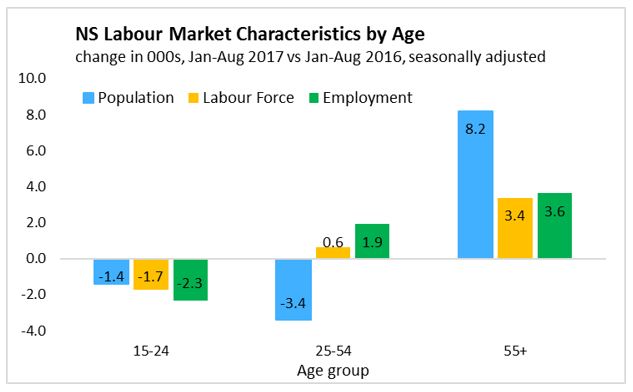
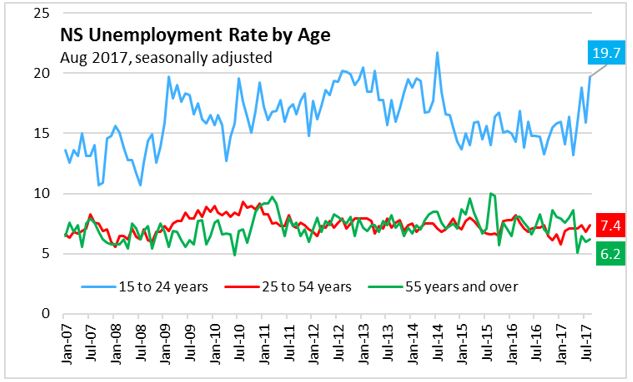
SECTORS (January-August 2017 vs. January-August 2016)
Comparing the first eight months of 2017 to the first eight months of 2016, employment in goods-producing sectors increased by 400 jobs. Employment gains in agriculture, utilities and manufacturing were enough to offset a loss in construction, and forestry/fishing/mining/gas.
There was a net gain of 2,800 jobs in service-producing sectors. Strong employment gains in wholesale/retail trade, professional services, and public administration were enough to override the job losses in financial services, educational services, accommodation/food services, health care, information and cultural industries, and transportation and warehousing.
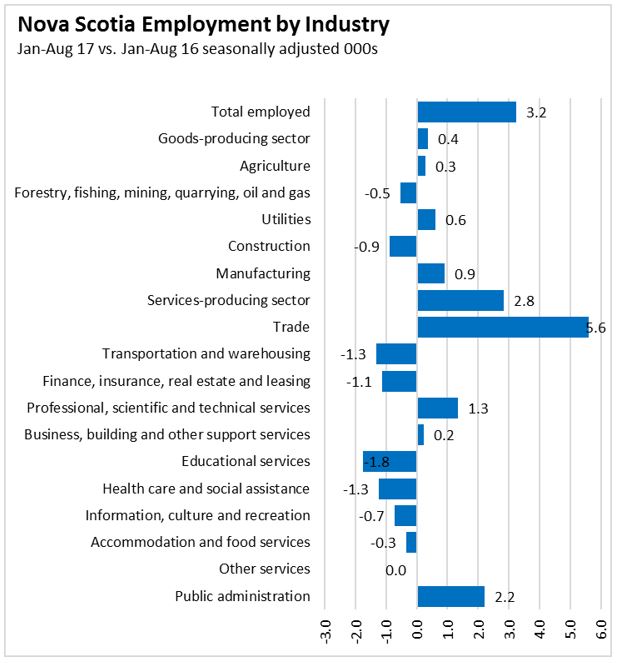
The increase in employment for the first eight months of 2017 over the same period in 2016 occurred with employees increasing by 2,600 while the number of self-employed increasing by 600. The gain in employees occurred the in public sector while there was a slight decline in the private sector.
Regions (3 month moving average, January-August 2017 vs. January-August 2016)
For the first eight months of 2017 compared to the first eight months of 2016, three regions (North Shore, the Valley and the South shore) reported employment growth that outpaced labour force growth, resulting in lower average unemployment rates. The Cape Breton region had no change in its level employment level combined with a falling labour supply. This combination caused the unemployment rate to fall 1.7 percentage points to 14.3 per cent. The Halifax economic region was the only regions to see its unemployment rate climb. This was due to falling employment combined with no change in labour supply to cause the unemployment rate to rise.
The Cape Breton region reported no change in average employment levels for the first eight months of 2017 over the first eight months of 2016. The labour force decreased by 1,100 (-1.9 per cent) for the same period. With no change in labour demand while labour supply fell, the result was a 1.7 percentage point decrease in the unemployment rate to 14.3 per cent.
For the North Shore region, employment increased 1,500 (2.3 per cent) for the first eight months of 2017 over the same period in 2016. Labour supply increased by 1,200 (1.7 per cent) for the same period. The increase in labour demand resulted in a 0.6 percentage point decline in the unemployment rate to 9.1 per cent.
The Annapolis Valley reported an increase in employment of 2,200 (4.0 per cent) and an increase in the labour force of 1,800 for the first eight months of 2017 over the same period in 2016. The net result was decrease of 0.8 percentage points in the average unemployment rate to 7.9 per cent.
The Southern region saw a slight increase of 200 (0.3 per cent) in employment along with a small drop of 400 in the labour force for the first eight months of 2017 over the first eight months of 2016. The unemployment rate was down 0.9 percentage points to 10.2 per cent.
Comparing the first eight months of 2017 to the first eight months of 2016, Halifax (HRM) experienced a decrease in employment of 1,100 (-0.5 per cent) along with no change in the labour supply. These adjustments resulted in 0.4 percentage point rise in the unemployment rate to 6.8 per cent.
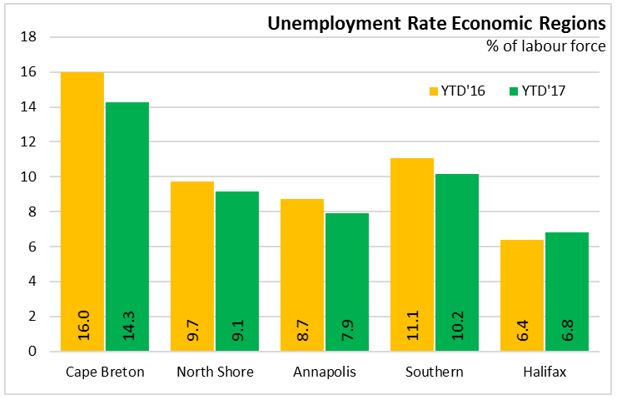
Provincial Comparisons
Employment increased 1.8 per cent in Canada comparing January-August 2017 with January-August 2016. Employment grew on a year-to-date basis in nine provinces with the largest gains in British Columbia (+3.8%), Prince Edward Island (+3.0%), and Quebec (+2.4%). Employment in Newfoundland and Labrador (-4.1%) declined over the first eight months of 2017 compared to 2016.
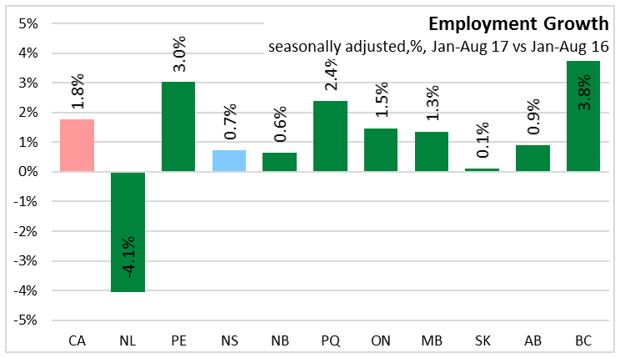
The Nova Scotia unemployment rate was 8.9 per cent in August 2017. In August of last year, the Nova Scotia unemployment rate was 8.5 per cent. Eight provinces have lower unemployment rates compared to the same month a year ago, with Prince Edward Island (-3.2 percentage points) having the steepest decline. The unemployment rate was higher in Newfoundland and Labrador (+2.3 percentage points) and Nova Scotia (+0.4 percentage points)compared to August 2016. The lowest unemployment rate among the provinces in August 2017 was in Manitoba at 4.9 per cent while the highest was in Newfoundland and Labrador at 14.7 per cent.
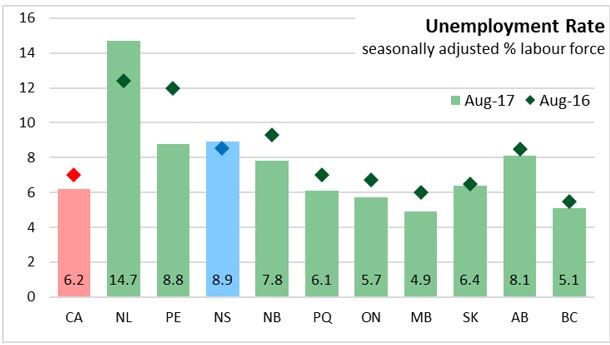
National Comparisons: Cities
The seasonally adjusted unemployment rate for the Halifax Census Metropolitan Area this month was 7.1 per cent. Quebec (3.8%) had the lowest unemployment rate for a CMA this month while the highest was in Edmonton (8.7%)
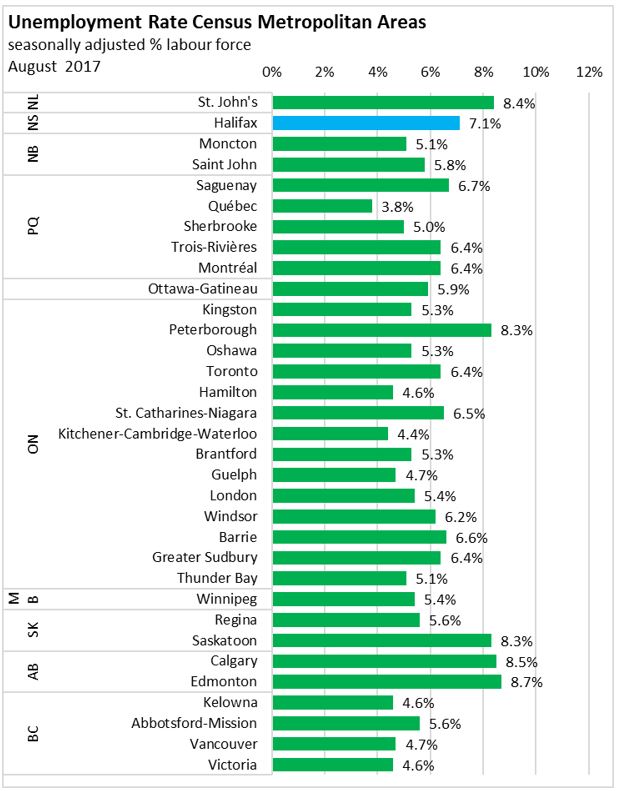
The seasonally adjusted employment rate for the Halifax Census Metropolitan Area was lower than last month at 62.2 per cent in August 2017.
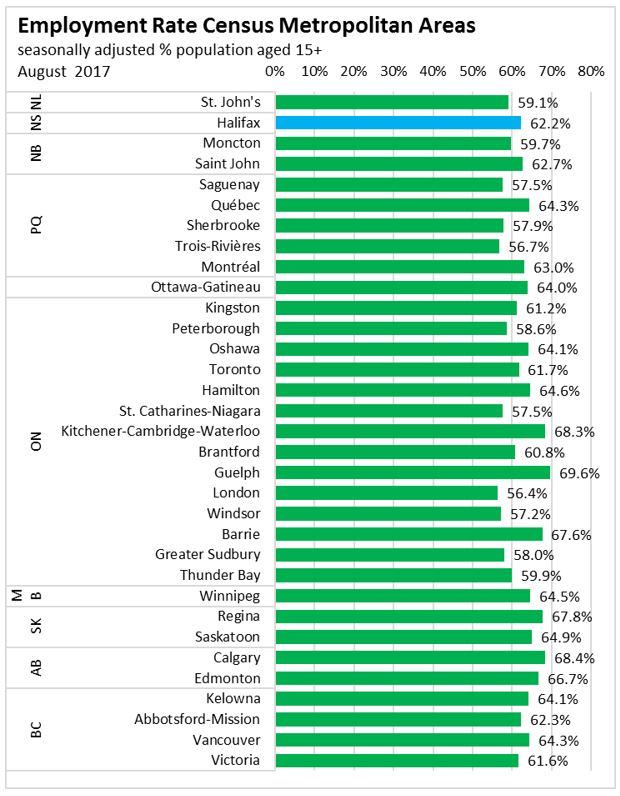
The three month average employment ending in August for the Halifax CMA was down 0.8 per cent compared to the three month period ending in July. The largest gain among CMAs was in Brantford, Ontario where employment rose 2.2 per cent.
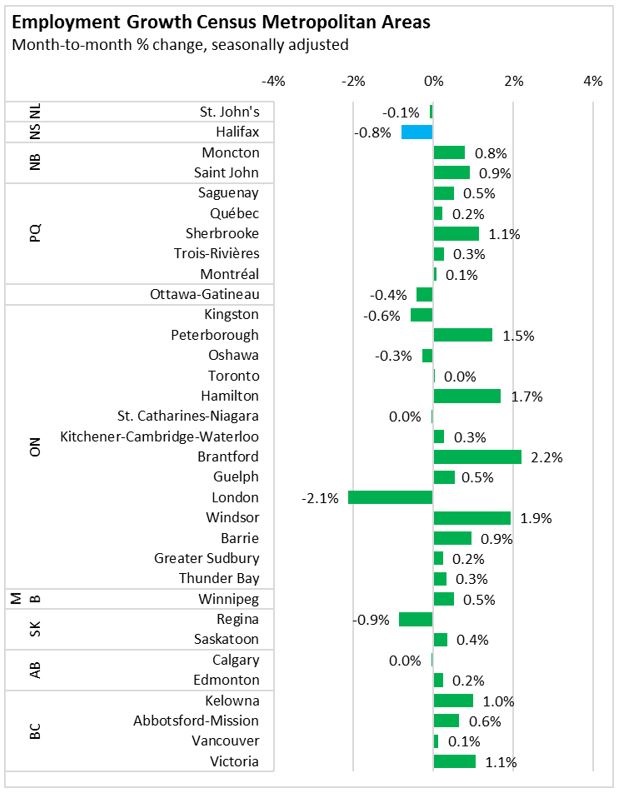
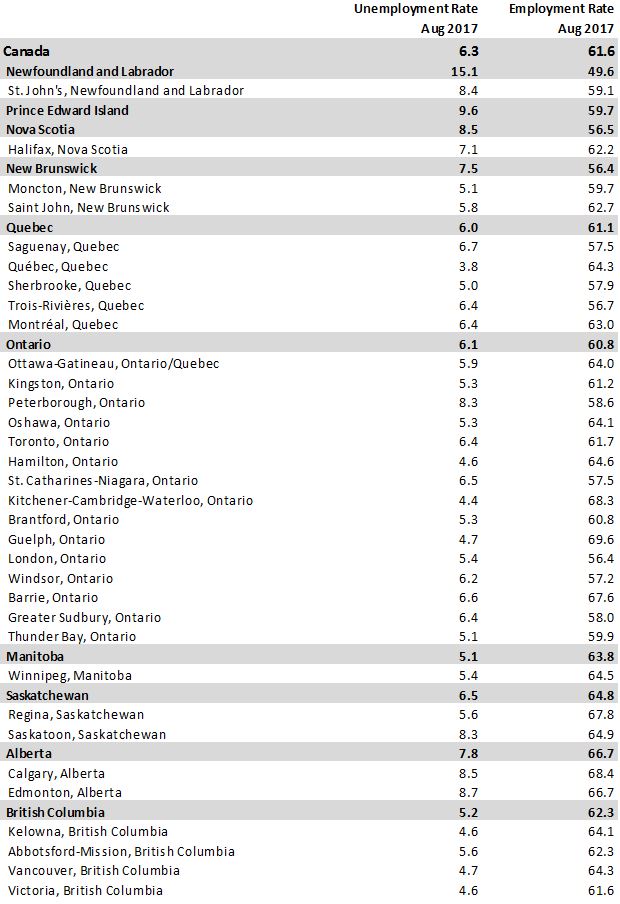
Note: Seasonally adjusted, 3 month average.
<--- Return to Archive